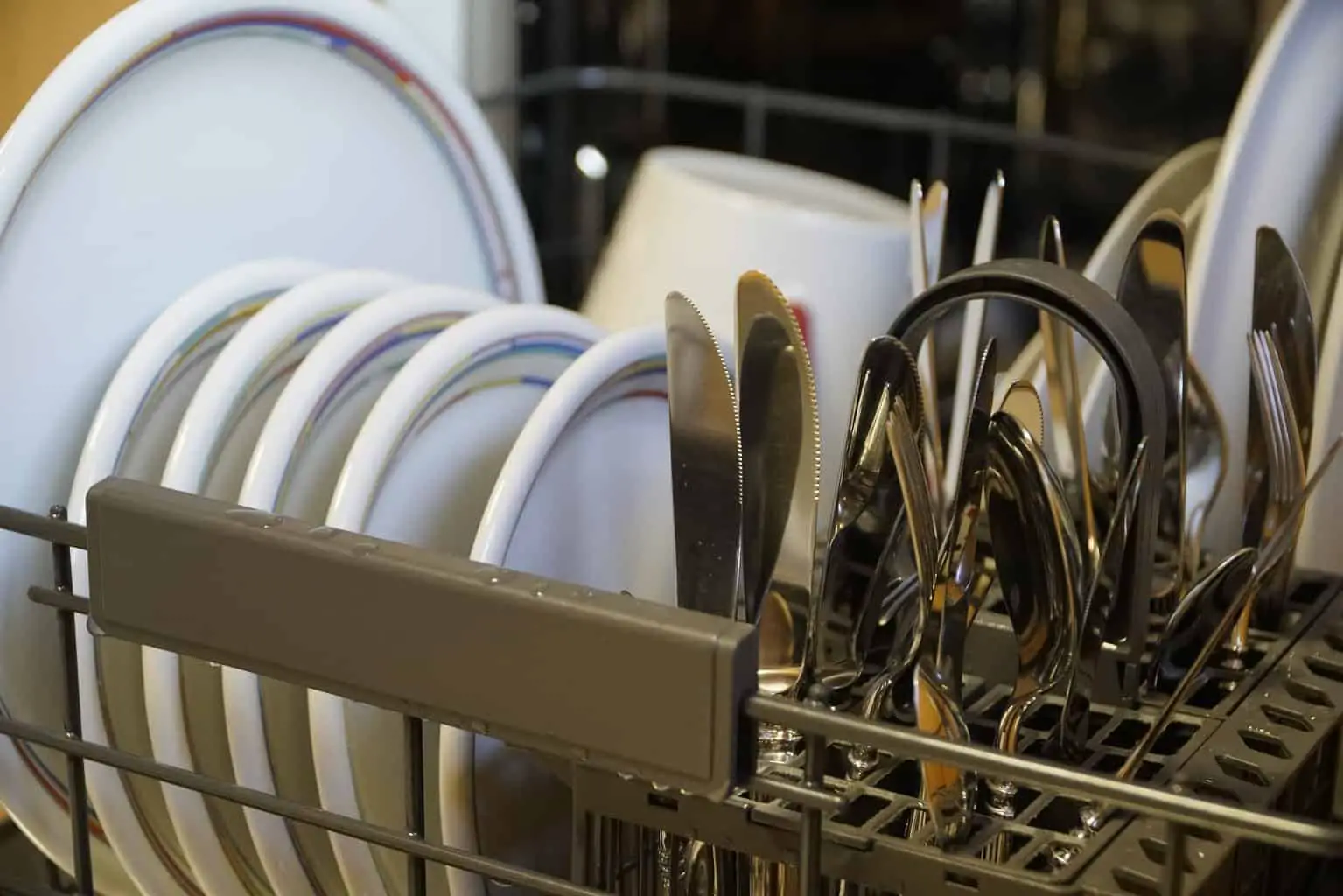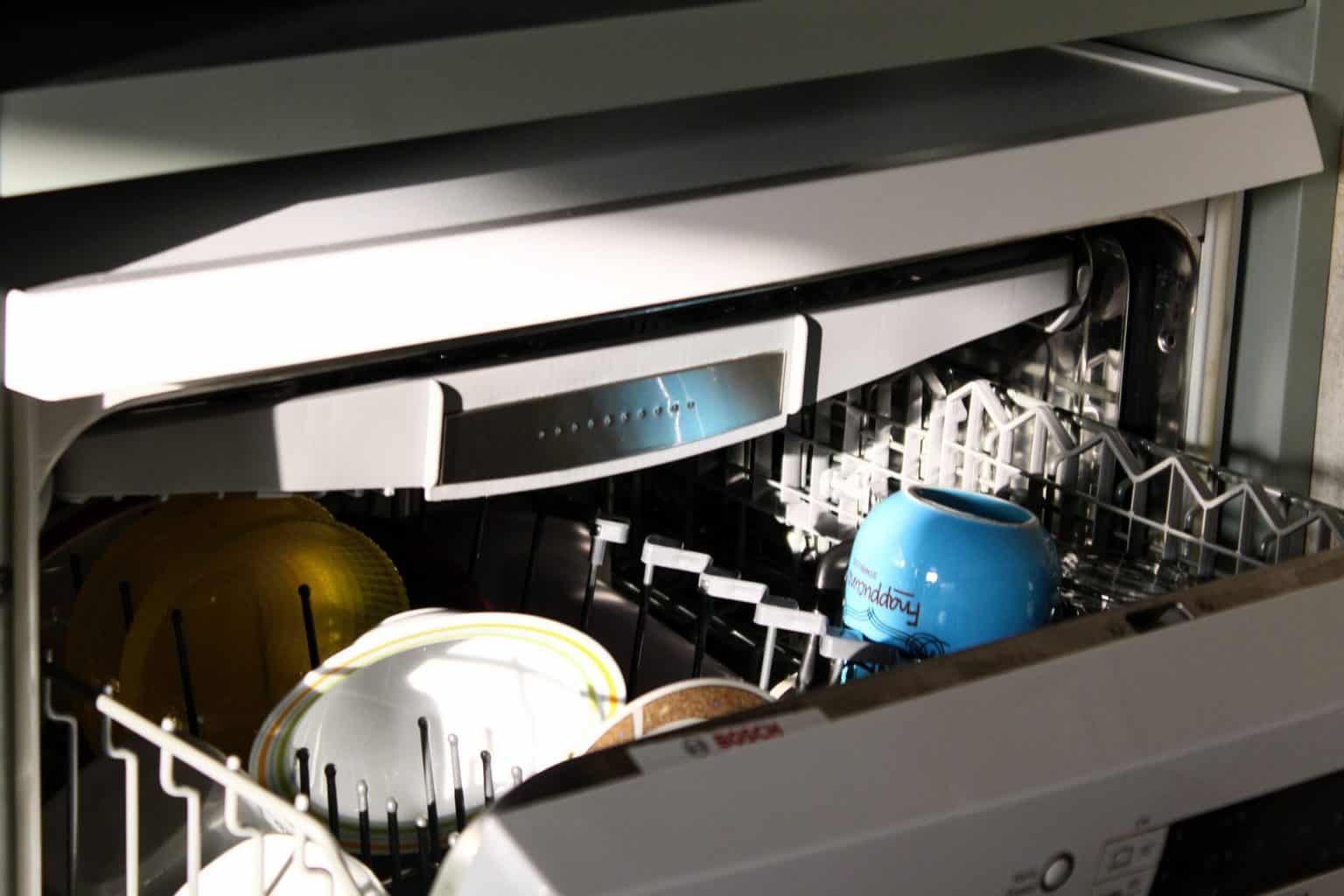As an Amazon Associate we earn from qualifying purchases.
Many of us have been in this situation before. You open the dishwasher, ready to put the plates away, only to look down and see a puddle of soapy, filthy water at the bottom. If your dishwasher is clogged, don’t call the plumber right away. You can fix a clogged dishwasher drain by following these steps.
Contents
Cleaning
You may believe you can get away with not cleaning your dishwasher because it’s running constantly with hot soapy water. If only that were the case.
Basic dish cleaning isn’t overly hard on your appliance. But cleaning heavy pots and pans that have grease can clog your drains.
Cleaning blenders like your Vitamix in the dishwasher is convenient, but fibrous vegetables can get stuck over time.
Aside from accidental bits of food that could potentially enter any crack or opening, your dishwasher may struggle with limescale, mold, and mildew. You should know how to clean a dishwasher drain.
Dirty Filter
The filter in your dishwasher is the most important component to consider since it gathers all of the food particles that are scraped off of your plates.
Filters are generally placed at the bottom of the machine beneath the lower rack and must be removed for access. For further information, consult your manufacturer’s instructions.
After removing the filter, clean it with hot running water and dish soap. If necessary, use a soft brush to remove tough debris from the screen, canister, or basket.
Depending on how frequently you use the dishwasher, your dishwashing filter should be cleaned at least once a month.
Heavy users may wish to have their filters cleaned every week, while light consumers may be able to get by cleaning them only every two years.
We propose that you check your filter on a regular basis and clean it as needed.
Gunky Door
Another location to clean is the dishwasher door, which may be difficult to access. Food and debris can accumulate around the edges of the door (including the bottom) and around the door gasket, making it difficult to access.
For light cleaning, use a moist cloth; if that doesn’t work, try using a little dish soap or vinegar. Remove stubborn particles with a toothbrush or other soft brush.
Deep Cleaning
Just like how you can automatically self-clean a washer gasket, you can use the deep cleaning function of a dishwasher.
- Fill a container with 1-2 cups of white vinegar and place it on the rack of an empty dishwasher for a de-liming/deep cleaning (depending on your machine’s design, you may want to put it on the top or bottom rack for optimum cleaning-if your user handbook doesn’t mention it, test each rack).
- Run a full cycle at the maximum temperature to completely clean and disinfect the appliance interior.
- As a result of the dishwasher’s operation, the vinegar will be dispersed throughout the machine.
This should be done at least once every few months, or when the appliance starts to smell bad.
Clearing Blockages
If your dishwasher isn’t draining properly or not at all, there’s probably a blockage.
You should be able to tell where the obstruction is based on the signs: sluggish or no drainage indicates an issue with the dishwasher drain or hose, while poor cleaning implies blocked spray nozzles.
Clogged Spray Arm
Food debris, mineral deposits from hard water, and even spray nozzles on dishwasher spray arms can be cumbersome to remove.
If you detect food debris, as well as mineral reserves from hard water, can readily clog the nozzle of the cleaner’s spray arms.
If you detect a reduction in cleaning power or find something obstructing the holes, consult your operating manual for instructions on removing the arms.
After removing them, soak them in a vinegar-water solution for at least 20 minutes before carefully cleaning out the gaps with a pipe cleaner or clip (don’t really use toothpicks, they can snap off within the arm).
Clogged Drain Horse
The drain hose might be clogged if your dishwasher takes a long time to drain or doesn’t drain at all.
These blockages are more probable the less scraping is done before loading dishes, and the dishwasher is discharged via a garbage disposer (which may contribute its own debris to the drain line). In order for it to be cleaned, you’ll need to temporarily disconnect the hose from the machine.
Clogged Drain Sump
If the hose appears to be clear, it’s possible that the blockage is in the dishwasher drain itself, specifically the tiny sump at the bottom of the machine.
Despite having a lid over/around it, this is where all of the wastewater exits via a hole (it may also be clogged despite having a cover over/around it).
Remove any debris from the hole (your straightened clothes hanger could aid here as well).
Clogged Air Gap
Not all dishwasher installations include air gaps, but if you do, they’re another location to investigate for blockages. Clogged air gaps will usually show themselves in a variety of ways. Water from the dishwasher that typically falls through the gap with a little leakage will begin to seep out faster.
Remove the air gap cover and inspect the interior. If there is any gunk inside, use a bottle or pipe brush to clean it out. You may also flush it with hot water. A funnel may be useful depending on the size and shape of the air gap.
Blockages may also get into the hose that connects the air gap to the sink drain/garbage disposal. These are generally held in place with a worm clamp or spring clip, just like the dishwasher hose. If you suspect there is a blockage, unplug the hose and clean it out completely.
Maintenance
Furthermore, aside from knowing how to clean the dishwasher drain, there are a few regular maintenance activities you should complete. If you’ll be moving the dishwasher, remember to turn off the electricity.
Check that the dishwasher door closes tightly on a regular basis. If it’s loose or jiggles, tighten it to keep water from escaping and the machine from shutting down in the middle of a cycle if it detects an open door.
Follow the manufacturer’s instructions to properly tighten your door; some will enable adjustments made with springs at the bottom, while others require an adjustable fasten plate on the machine’s top frame.
While you’re looking through the door, take a check at the gasket that surrounds it. If the seal is damaged, dried out, or otherwise unsuitable, you should replace it.
- First, determine if the gasket is covered during your warranty period.
- Check the dishwasher racks on a regular basis for any chipping or wear of the coating: if it persists, it will cause greater damage and rust of the metal below.
- Replacement tine tips are available at any hardware shop and simply slot onto broken ends.
- If you need to perform a more extensive repair, look for dishwashing rack paint.
Final Thoughts
It may surprise many people to find that learning how to unclog a dishwasher drain without the assistance of a specialist is actually quite simple. However, if not done correctly, your dishwasher’s seal could deteriorate further.
To clean your dishwasher drain, you must first know how to clean the dishwasher drain and remove any obstructions from the drain hose, unblock the drain, and clean the filter. You can also prevent clogs by following the proper care instructions.



